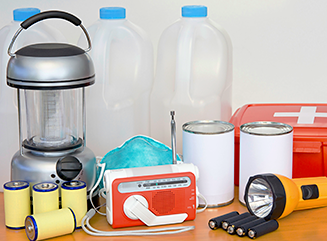 Water, one gallon of water per person per day for at least three days, for drinking and sanitation
Water, one gallon of water per person per day for at least three days, for drinking and sanitation- Food, at least a three-day supply of non-perishable food
- Battery-powered or hand crank radio and a NOAA Weather Radio with tone alert and extra batteries for both
- Flashlight and extra batteries
- Hurricane candles with matches stored in waterproof container. Be especially careful with open flames!
- First aid kit
- Whistle to signal for help
- Dust mask to help filter contaminated air and plastic sheeting and duct tape to shelter in place
- Moist towelettes, garbage bags and plastic ties for personal sanitation
- Wrench or pliers to turn off utilities
- Manual can opener for food
- Local maps
- Cell phone with chargers, inverter or solar charger
- If you still have a landline, keep an “old fashioned” phone that can still be used when the power is out and cell towers are overwhelmed.
- Prescription medications and glasses - Ask your doctor about storing prescription medications such as heart and high blood pressure medication, insulin and other prescription drugs. Consider rotating your medicine supplies.
- Pet food and extra water for your pet
- Cash or traveler's checks and change
- Important family documents such as copies of insurance policies, identification and bank account records in a waterproof, portable container. You can use the Emergency Financial First Aid Kit - EFFAK (PDF - 977Kb) developed by Operation Hope, FEMA and Citizen Corps to help you organize your information.
- Sleeping bag or warm blanket for each person. Consider additional bedding if you live in a cold-weather climate.
- Complete change of clothing including a long sleeved shirt, long pants and sturdy shoes. Consider additional clothing if you live in a cold-weather climate.
- Household chlorine bleach and medicine dropper – When diluted, nine parts water to one part bleach, bleach can be used as a disinfectant. Or in an emergency, you can use it to treat water by using 16 drops of regular household liquid bleach per gallon of water. Do not use scented, color safe or bleaches with added cleaners.
- Fire extinguisher
- Matches in a waterproof container
- Feminine supplies and personal hygiene items
- Mess kits, paper cups, plates, paper towels and plastic utensils
- Paper and pencil
- Books, games, puzzles or other activities for children
- Create emergency response cards for each of your family members. Each family member should know what the other members are supposed to do.
Knowing how to treat minor injuries can make a difference in an emergency. You may consider taking a first aid class, but simply having the following things can help you stop bleeding, prevent infection and assist in decontamination.
- Two pairs of Latex or other sterile gloves if you are allergic to Latex
- Sterile dressings to stop bleeding
- Cleansing agent/soap and antibiotic towelettes
- Antibiotic ointment
- Burn ointment
- Adhesive bandages in a variety of sizes
- Eye wash solution to flush the eyes or as general decontaminant
- Thermometer
- Prescription medications you take every day such as insulin, heart medicine and asthma inhalers. You should periodically rotate medicines to account for expiration dates.
- Prescribed medical supplies such as glucose and blood pressure monitoring equipment and supplies
Non-prescription drugs:
- Aspirin or non-aspirin pain reliever
- Anti-diarrhea medication
- Antacid
- Laxative
- Scissors
- Tweezers
- Tube of petroleum jelly or other lubricant
For Baby:
- Formula
- Diapers
- Bottles
- Powdered milk
- Moist towelettes
- Diaper rash ointment
As with all perishable items or items with a specified shelf life, consider rotating your stock to make sure the stored items do not expire.
Make a plan for all in your household so everyone knows what to do if they can’t reach a parent or someone in authority. Practice the plan!